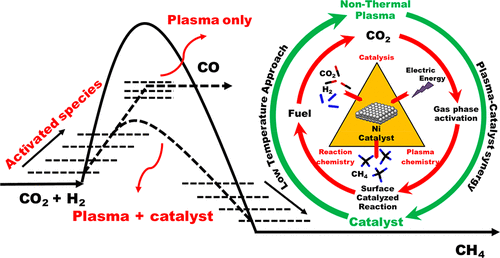当前位置:
X-MOL 学术
›
ACS Sustain. Chem. Eng.
›
论文详情
Our official English website, www.x-mol.net, welcomes your
feedback! (Note: you will need to create a separate account there.)
Low-Temperature CO2 Methanation: Synergistic Effects in Plasma-Ni Hybrid Catalytic System
ACS Sustainable Chemistry & Engineering ( IF 7.1 ) Pub Date : 2020-01-21 , DOI: 10.1021/acssuschemeng.9b06180 Farhan Ahmad 1 , Emma C. Lovell 1 , Hassan Masood 1 , Patrick J. Cullen 2 , Kostya Ken Ostrikov 1, 3, 4 , Jason A. Scott 1 , Rose Amal 1
ACS Sustainable Chemistry & Engineering ( IF 7.1 ) Pub Date : 2020-01-21 , DOI: 10.1021/acssuschemeng.9b06180 Farhan Ahmad 1 , Emma C. Lovell 1 , Hassan Masood 1 , Patrick J. Cullen 2 , Kostya Ken Ostrikov 1, 3, 4 , Jason A. Scott 1 , Rose Amal 1
Affiliation

|
Thermodynamic and kinetic limitations can restrict the feasibility and scalability of conventional catalytic processes for CO2 methanation at the industrial level. Due to its nonequilibrium nature, nonthermal plasma (NTP) promises to reduce reaction barriers and make this gas conversion approach viable even at low temperatures. However, the current understanding of the fundamental chemical and physical behaviors in the hybrid plasma catalytic interactions is insufficient. This study demonstrates plasma-driven CO2 conversions approaching the reaction equilibrium with high methane yields even at low temperature (150 °C). It was observed that the addition of plasma to the catalytic bed enhanced the CO2 conversion around 20 times relative to thermal activity, whereas the CH4 selectivity increased around 5 times by introducing the nickel catalyst into plasma discharge compared to plasma only (at 150 °C). Moreover, the findings provide new insights into the gas phase activation of reactants (CO2 and H2) and the reaction over Ni0 to decouple the plasma and catalyst synergy. The catalyst did not undergo significant structural changes under plasma discharge, apart from a slight decrease in Ni crystallite size, while an enhanced metal dispersion was evident (24% to 42%, from CO pulse chemisorption). The optimized system achieved a CO2 conversion of 60% with a CH4 selectivity of over 97% at 150 °C, which required much higher temperatures (320–330 °C) to achieve equivalent conversion in thermal catalysis. This study is a step toward an understanding and effective control of the plasma enhanced catalytic CO2 transformation via low energy reaction pathways that utilize the NTP for low-temperature CO2 methanation with high conversion, selectivity, stability, and controllability.
中文翻译:

低温CO 2甲烷化:等离子-镍杂化催化体系中的协同效应
热力学和动力学的局限性可能会限制常规催化工艺在工业水平上进行CO 2甲烷化的可行性和可扩展性。由于其非平衡性质,非热等离子体(NTP)有望减少反应障碍,并使这种气体转化方法即使在低温下也可行。但是,目前对混合等离子体催化相互作用中基本化学和物理行为的了解还不够。这项研究表明,即使在低温(150°C)下,等离子体驱动的CO 2转化率也接近甲烷的高产率,达到了反应平衡。观察到向催化床中添加等离子体增强了CO 2。相对于热活性,转化率约为20倍,而通过将镍催化剂引入等离子放电,与仅使用等离子(在150°C时)相比,CH 4选择性提高了约5倍。而且,这些发现提供了对反应物(CO 2和H 2)的气相活化以及在Ni 0上的反应以解耦等离子体和催化剂协同作用的新见解。除镍微晶尺寸略微减小外,催化剂在等离子放电下未发生明显的结构变化,而金属分散性明显提高(CO脉冲化学吸附作用为24%至42%)。经过优化的系统使用CH 4可以实现60%的CO 2转化率在150°C下的选择性超过97%,这需要更高的温度(320–330°C)才能在热催化中实现等效转化。这项研究是通过利用NTP进行低温CO 2甲烷化并具有高转化率,选择性,稳定性和可控制性的低能反应途径,朝着了解和有效控制等离子体增强的催化CO 2转化迈出的一步。
更新日期:2020-01-22
中文翻译:

低温CO 2甲烷化:等离子-镍杂化催化体系中的协同效应
热力学和动力学的局限性可能会限制常规催化工艺在工业水平上进行CO 2甲烷化的可行性和可扩展性。由于其非平衡性质,非热等离子体(NTP)有望减少反应障碍,并使这种气体转化方法即使在低温下也可行。但是,目前对混合等离子体催化相互作用中基本化学和物理行为的了解还不够。这项研究表明,即使在低温(150°C)下,等离子体驱动的CO 2转化率也接近甲烷的高产率,达到了反应平衡。观察到向催化床中添加等离子体增强了CO 2。相对于热活性,转化率约为20倍,而通过将镍催化剂引入等离子放电,与仅使用等离子(在150°C时)相比,CH 4选择性提高了约5倍。而且,这些发现提供了对反应物(CO 2和H 2)的气相活化以及在Ni 0上的反应以解耦等离子体和催化剂协同作用的新见解。除镍微晶尺寸略微减小外,催化剂在等离子放电下未发生明显的结构变化,而金属分散性明显提高(CO脉冲化学吸附作用为24%至42%)。经过优化的系统使用CH 4可以实现60%的CO 2转化率在150°C下的选择性超过97%,这需要更高的温度(320–330°C)才能在热催化中实现等效转化。这项研究是通过利用NTP进行低温CO 2甲烷化并具有高转化率,选择性,稳定性和可控制性的低能反应途径,朝着了解和有效控制等离子体增强的催化CO 2转化迈出的一步。











































 京公网安备 11010802027423号
京公网安备 11010802027423号